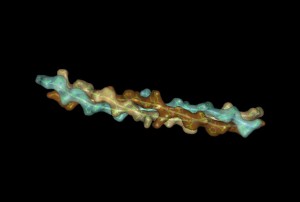SUNDAY, 13 MAY 2012
The average age of the British public is steadily rising. Life-expectancy has increased substantially in recent years, and this coupled to a decline in birth rate means that society now has more pensioners than teenagers.The biological effects of aging are clear for all to see: the inevitable appearance of wrinkles, reduced mobility, increased incidence of arthritis and diabetes, reduced heart and kidney function and loss of sight. Most of these put a strain on global health services, as well as increasing dependence and the burden of care. But what if we could slow down the aging process? What if poor health did not have to go hand in hand with advancing years?
Many researchers have investigated the aging process and the ways in which it can be manipulated to better the quality of life in later years. A common feature of many of the afflictions associated with aging is reduced function in proteins that hold the cells and tissues of our body together. Many of these proteins have a life that spans tens of years. They are therefore subject to many chemical and enzymatic modifications that can affect their native function over time.
One such modification that is prevalent in old age is protein glycation. Glycation occurs when a sugar molecule – most frequently glucose – chemically reacts with a protein or its derivatives. The resulting protein modification is known as an Advanced Glycation End product (AGE). This AGE has the potential to chemically link itself to a second protein to form a cross-link that restricts flexibility and elasticity and thus reduces protein function.

The proteins that are most commonly damaged by glycation are those that are not recycled quickly by enzymes in the body. Protein recycling can keep cross-links in check as AGEs are destroyed with the protein. If this ‘turnover’ is very slow, however, glycation accumulates. The protein collagen is one such affected molecule as in some instances it may not be replaced within a lifetime. Collagen makes up 30 % of total protein in the body and forms the basis of many vital organs such as the heart, kidney and skin. Because of its ubiquity and age, collagen is very commonly subject to glycation in the elderly. Cross-linking of collagen can reduce elasticity of the skin or lead to the formation of cataracts in the eyes. It can also cause stiffness in the arteries and walls of the heart that may eventually lead to heart failure.
Besides the elderly, people who suffer with Type II diabetes are particularly badly affected by AGE cross-linking. Whilst older people have an abundance of long-lived protein that has slowly accumulated the cross-links, Type II diabetics have abnormally high levels of glucose in their system leaving a surplus available to glycate the protein.
Ultimately AGE cross-linking will affect us all as we grow older, however, it is not all bad news. Studies indicate that a simple yet effective solution to this problem is at hand: exercise. It was discovered that the more weight-bearing exercise one does, the more frequently collagen is turned over and so fewer cross-links accumulate. This is a great preventative measure for people who are concerned about the effects of aging in later life. Few octo- and nonagenarians, however, are predisposed to wrestling a 10 mile jog twice a week.
Dietary restriction is another simple way to keep AGE accumulation in check. Reducing the amount of sugar consumed can help to reduce the surplus that is available and thus help to prevent protein modification. Furthermore, foods cooked at high temperatures such as grilled or fried meats are a source of externally-formed AGEs. When consumed these can form cross-links with proteins residing in the body. Restricting the consumption of these foodstuffs would also help slow AGE accumulation in bodily tissues. Regular exercise and a moderate diet that is rich in lightly cooked vegetables – sound familiar?
From a more medical standpoint, numerous would-be therapeutics are currently in development. These aim to reduce AGE formation in the body by inhibiting different steps in the chemical reaction. One such drug is aminoguanidine. It sequesters reactive intermediate components of the glycation reaction and thus ultimately prevents the linking of glucose to the protein. This drug is currently in clinical trials but so far has shown low activity and some nasty side-effects such as anaemia in humans and kidney tumours in rats. Other drugs are being developed that follow the same kind of mechanism, but no stand-out success stories have been reported yet.
Although the solutions and treatments mentioned above offer great ways to prevent protein cross-linking from occurring in the future, few of them do anything to tackle the proteins that have already been cross-linked within the body. We need a treatment that can destroy AGE- linked protein without altering other important proteins that reside close to the damaged sites.
A promising small molecule drug that went by the name of Alagebrium was designed to breakdown protein cross-links in order to restore the proteins to their natural state. It showed encouraging results in human clinical trials. Some patients reported dramatic improvements in movement and flexibility, along with other health benefits such as improved kidney function and hypertension. In several instances where Alagebrium was fed to old-aged dogs, their quality of life reportedly improved as agility, flexibility and general youthfulness was restored. Unfortunately, the company that pioneered this treatment encountered financial difficulties and terminated all investigation in to this promising therapy.
Our lab is looking for new types of these ‘AGE-breaker’ treatments. We are funded by the SENS Foundation who work to develop and promote rejuvenation biotechnologies that address the disabilities and diseases of aging. Finding a successful AGE-breaker is a very challenging prospect. By their very nature, protein cross-links are hidden deep down within tissues and fibres, and so it is very hard for any conventional treatment to reach them and break them down. While it would seem sensible to use an enzyme to chew its way through cross-links, freeing the proteins and renewing tissue flexibility, unfortunately even enzymes may be too big to fit into the tiny gaps between densely-packed collagen fibres. On the plus side, the AGE cross-links are quite dissimilar chemically to anything else in the body. Therefore specifically targeting them should be straightforward if we can find the right drugs to do the job and if we can actually get these to the AGEs in the first instance.
But who would be willing to pay for the research necessary to find these age-busting treatments? In an aging society, we are always striving to prevent wrinkles, to stay youthful and to keep our health, looks and fitness for as long as possible. The cosmetics industry feeds millions of dollars every year into research to find the next big skin cream that ‘reduces the signs of aging’. If a proportion of this funding was directed toward investigation into protein cross-link breakers, success in this area could be quick and plentiful.
For now, the problem remains to find a treatment which can help prevent or remove protein cross-linking to improve health and quality of life in the older generation. For a new post-doc at Cambridge the issue seems a bit remote, but one day everybody will reach old age. It will be at this time when we really wish more effort had been diverted towards holding off or even reversing the decline in physical and mental faculties that today are the inevitable result of getting old. Continued research into this area may one day reveal the sought after cure that allows us to stay healthy, youthful and productive for longer.
Rhian Grainger is a post-doctoral researcher at the Institute of Biotechnology.


